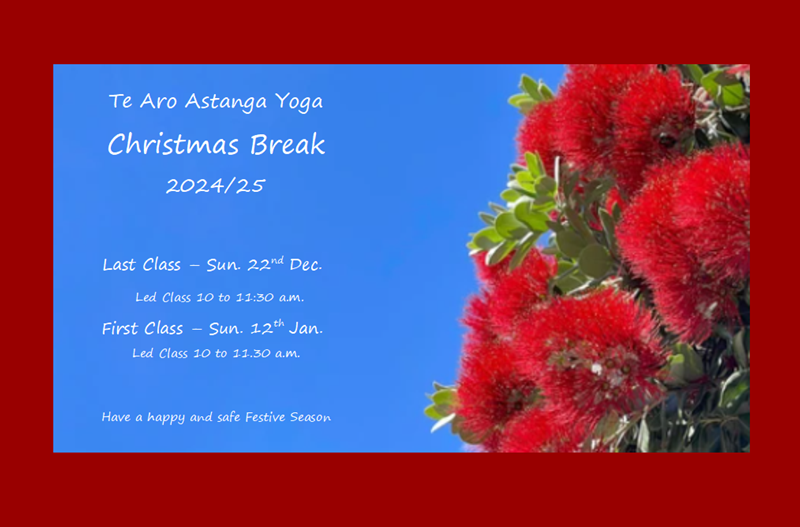It is Winter in Aotearoa/NZ at the moment and this can be a difficult season for practice. We often have more time but experience the resistance in the body and the challenge to be motivated that are hallmarks of the colder months. Next year, 2022, I will have been doing this practice for 30 years and the best way I have found to get through the more challenging times is to let go a little of the physical side of the practice and look at what is really happening.
So, to start with we roll out our Yoga mat. And if you’re lucky you do this in a warm studio in the embrace of the sangha/community of fellow practitioners and under the eye of an experienced and caring teacher. If you are me, you are lucky enough to do this at home, with the heat pump blazing and in the company of the beautiful Victoria. Come to Samasthiti and chant the Opening Mantra, paying respect to our Guru and to Patanjali, our parampara/lineage.
Then again, Samasthiti and I always take some breaths here, taking the time to feel my body. To feel my feet on the floor, toes pressed, insteps gently lifted. Feel the energy rising up through the floor, the steady strength of the calves and thighs, gentle lift of the bottom of the rib cage, a lengthening of the spine. Tuck the chin a bit and feel the length come in to the cervical/neck. Shorten the gaze and hold it steady.Come in to the body and feel the energy there. Observe the breath, calm, steady and soft. Listen to the sound of the breath. Feel the movement of the breath in the body, the gentle expansion of the chest as you inhale, the gentle contraction of the breath as you exhale. Feel the diaphram driving the breath, drawing down into the stomach on the inhale, moving slowly back to the bottom of the rib cage on the exhale. Be in the breath, in the body. Not thinking, justing feeling and observing.
And then we start vinyasa, breathing and moving. On the first inhale slowly lift the arms above the head and feel the movement of the shoulders rotating open as the arms come up and then closed as the hands come together above the head. Feel the way we bring the energy in as we gently press the hands, and then draw that energy down into the body as we exhale and softly fold forward. Feel the movement of the bottom of the rib cage forward away from the pelvis as we inhale lift the head up and lengthen the spine. And so it goes, moving and breathing. Carefully observing the breath and the body as we move.
Like this, we start to notice where there is resistance in the body. We notice the little imbalances. We notice that the body is not the same today as it was yesterday. We notice that the breath is not the same as it was yesterday and slowly we learn to accept this and to be comfortable with the change. We learn where the limits of our body are and we learn that with time and patience, if we bring the energy into the parts of the body that are resisting then we can release some of the blockages in our body. Slowly we can allow the body to achieve it’s full potential. In this way we learn that we can change how we hold and use the body. We can change the poor patterns of behaviour we have in the body. Slowly we become aware of a strengthening in the pelvic floor, low down in the centre of the body and how this improves the posture and drives the energy correctly around the body. What we thought was impossible, becomes possible!
At the same time we are practicing holding our focus steady. Not thinking but observing. Not letting the mind wander, not allowing that voice in our head to distract us. Slowly, this becomes easier and we find that we can concentrate better and for longer. And then we realise that our mind is just another part of our body, like our muscles and joints and that we can change the patterns of thinking that are our habit. We learn that we can choose what we think about things, that we can control our thinking. What an incredibly powerful tool! We can start to practice discernment so we can tell what thoughts are good for us and helpful and what thoughts are damaging. We can start to cultivate helpful thinking and avoid harmful thinking.
Then we notice that we are happier. The lasting happiness of contentment. And it doesn’t matter that we can’t bind in Marichasana D or that it’s a little chilly or a little windy. How did we get here? One breath, one vinyasa at a time. Slowly and with good grace, just practice.

Love this. Thank you Mike 🙂
Thank you Mike – you are inspiring me to practice through the winter, one breath, one vinyasa at a time with good grace
Beautiful ❤️
Thank you Mike for explaining what it is that you do on the inside – when to the outside it looks like you are just standing there. This will be helpful for my next trip to the yoga studio.
Thankyou Mike. What a beautiful sharing of the gifts of our Astanga practice.